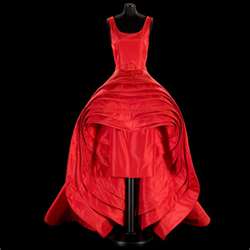Lady Lever Art Gallery, Port Sunlight, Liverpool.
27 May to 11 December 2011The Lady Lever Art Gallery was built in 1922 by the philanthropist and factory owner William Hesketh Lever, set in a purpose built model village Port Sunlight for all his factory workers, he believed that ‘art can be to everyone an inspiration.’ It was built in dedication to his wife and the gallery contains all his own personal collection of art work, so makes for an authentic, intimate experience to a fore gone decadent lifestyle which the exhibition also aims to display.
The Finishing Touch exhibition contains over sixty accessories from the National Museums Liverpool’s collection where some have never been on display before, set in three side rooms which lead off from one another in chronological date order. They are all brightly lit by overhead lights and individual spot lights inside the glass containers, illuminating the accessories as pieces of work of art to be adored and looked upon.
Each room has fashion illustrations drawn upon the boards on the walls of ladies wearing the fashion of the time, this visual approach leads to visitors being able to appreciate the accessories in the context of which they would have been worn and helps to visualise a background to the accessories. It also educates the visitor of fashion of the time without being seen as forced, as you progress through the three rooms you can see a visual representative of how the fashion has changed.
Each room has a bench to allow the visitor to relax and fully consider each accessory, which ties in with the rest of the gallery space atmosphere of being welcoming. A guide booklet is also available in each room, which gives examples of the fashion from the time period in which each room sits. It contains comical imagery from ‘Punch’ magazine which makes fun out of changes in fashion of the time, examples of fashion plates, illustrations from la mode illustrée and Vogue. The booklet contains no text so allows the viewer to form their own judgements and make back stories to the accessories, thus enabling a creative free flowing atmosphere. I think it is a way to successfully educate the visitor without giving numerous text examples which can seem overwhelming and not a leisurely enjoyment in which a gallery should aim to be.
The signage by the glass cabinets containing the accessories is minimal, it is on a white board and contains the key facts that are needed to know such as, what it is, materials used, date produced and who owned the item. The signage is clear and concise and is easily recognisable at a glance so doesn’t take the attention away from each individual item.
Some of my favourite items from the exhibition include an 1859 ‘Pork Pie’ hat which has a round, brown base, large brown feather from the side and elastic straps to keep it in position. It was considered to be shocking and only worn by ‘fast young ladies’ at the time.
There was a beautiful dark brown beaver fur bag with matching muff from 1880-90, which evoked a feeling of unadulterated glamour and excess which I could visualise on a lady travelling on a night train with an explicated lover.
It wasn’t until the mid nineteenth century that shoes were shaped for left and right feet until then women wore shoes that were seen to give them small, delicate features. My favourite pair of shoes from the exhibition is a pair of Russell and Bromley wedged suede shows from 1939, they are brightly coloured with royal blue and emerald green. Radiating wealth, glamour and the excess of the 1930’s upper class lifestyle. They are exciting to look at and at the time would have been quite a daring shoe, which I feel is still wearable and desired today.
In the early nineteenth century to 1940 fans were the fashionable accessory for stylish, decadent women and are suitably conveyed in the third exhibition room. They were seen as dualistic, as can be an extravagant extension of a dress but also used as an emotive device used for flirting by a means of communication.
In the final room of the exhibition it takes on a more interactive element with hats supplied by ‘Barstons Village hat hire’ available to try on from the time period of 1830 to 1940. This discredits the usual space of an exhibition of being one to look but not touch, it becomes more personal and the atmosphere is informal with people chatting about the hats and trying them on. A comments box was positioned by the exit of the exhibition as visitors were invited to give their own critique and leave messages about what they enjoyed, this enables the curator to become more personal with the public and dispel the notion of the hierarchy prevalent in gallery spaces.
The exhibition was extremely specialised in that it only showed the accessories of high class ladies and none of the working class or men between the periods of 1830 to 1940. It did however show the accessories in the best light and enabled the visitor to pursue them at their will and make their own judgments on them. I particularly enjoyed the exhibition as when I was progressing through each room I could see a clear transgression between time periods and was able to appreciate the glamour and excess that the ladies who wore the accessories would have enjoyed.






















